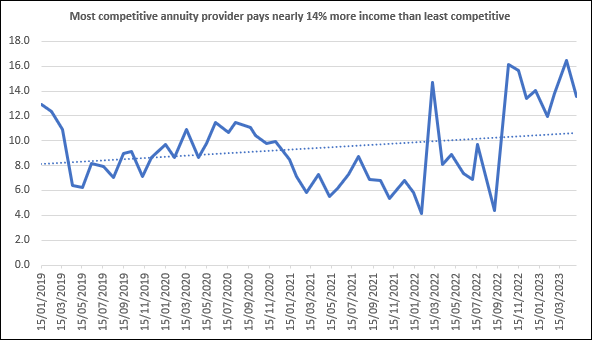Annuities are back with a bang – for your buck
Annuity rates are linked to interest rates and the rapid rise in sales is mirrored by the increase in interest rates over the past few months.
For every £100 of premium that has been invested this quarter, £70 of it has been invested with a different annuity provider on the open market
Stephen Lowe, Just Group
Big money
Between January and March 2023, 16,256 annuities were purchased, the largest number recorded since 17,252 were sold between July and September 2019.
Annuity premiums for the quarter totalled £1.2 billion, another highest value since 2015 when the pensions freedoms were introduced.
Pension freedoms gave savers greater flexibility over how they could access their retirement savings and as rates were low, many abandoned annuities in favour of flexible drawdown, leading to a slump in the market.
Inflation protection was also flavour of the quarter, with sales of escalating annuities – that are indexed and increase annually – grew by 23%.
ABI director of long term savings policy Yvonne Braun, said: “Annuities offer a guaranteed income for life, like a final salary pension scheme.
“It’s great to see more people taking advantage of the protection annuities have to offer, especially given the current favourable rates.
“Securing a guaranteed income for life remains an important part of the mix of options for people to consider at and during retirement.”
The power of shopping around
What is more encouraging is that for the first time since 2016, more than 10,000 people executed their right to shop around and bought an annuity from a different provider to their pension savings provider.
In total, 64% of sales totalling £847 million changed provider compared with only 55% during the same period in 2022.
This is particularly significant, said Stephen Lowe, group communications director at retirement specialist Just Group.
“For every £100 of premium that has been invested this quarter, £70 of it has been invested with a different annuity provider on the open market.”
That is the highest Lowe has seen the use of what used to be called the ‘open market option’ (OMO) and is particularly important for consumers who not only shop around, but declare their medical conditions.
“Consumers can get significantly more retirement income by shopping around. They may not realise they can also get a higher income by disclosing details about their medical conditions and lifestyle factors,” said Lowe.
“A broker will help people by asking these questions. It’s really important people ask their pension company if they provide better rates by shopping around the market for them and taking their medical conditions into account.”
Just data shows that common chronic conditions such as obesity, type 2 diabetes and high blood pressure and provide around a 5% uplift against the worst quote for a 65 year old.
For more acute, life limiting conditions, such as stage 3 lung cancer, the difference between the best and worse quotes might be as much as nearly 90%.
Overall, the average difference between the best and worst quotes is currently 14%, said Lowe (see image below).
As interest rates have increased, so have annuity rates to the point that advisers cannot ignore the option as part of a retirement planning session.
Growing demand has also attracted one provider back into the market, with Standard Life recently announcing its return.
Claire Altman, managing director for individual retirement at Standard Life, told Pensions Expert: “As pot sizes grow, more focus will be drawn to retirement income solutions that truly meet customer need as the demand will be greater and the responsibility and opportunity to fulfil that demand will make it increasingly important and worthwhile.
“It is an exciting time for those that are involved in thinking about how to get it right for consumers.”

Annuities for DB transfers
Steve Webb, a partner at LCP is pleased at the resurgence, as a self confessed “fan of annuities”.
As a product, annuities are particularly useful in two situations. One is later life. “There’s a whole bunch of people with DC pots that will get to 78 or 82 and we don’t want them trying to struggle to manage their income.
“You can get not far shy of 10% annuity rates at the age of 80 with a five year guarantee period,” said Webb. So if you dropped dead the next day, the family will get the fund returned to them.”
The other situation is post-DB transfer, which may seem counterintuitive to take a DB transfer for flexibility and then sink a portion into an annuity.
But people don’t know how long they will live and
“Rather than an all or nothing DB transfer, you might use a portion to secure some income, then you will have state pension on top and you can then flex the rest,” said Webb.
“We speak to advisers and they often recommend an annuity with part of the transfer.”
Better products will deliver better outcomes
As to whether schemes or employers can do more to encourage individuals to consider an annuity as part of their retirement solution, great outcomes requires innovation, said Altman, and that will create better products that consumers will demand as they get older.
“The industry is at a crossroads in terms of how best to help people access these products at retirement,” said Altman.
“Inertia – through auto enrolment in accumulation – has been a great success and there is something to be said for continuing that approach through decumulation; while at the same time properly supporting those who want to (or should) take a different course.”






















